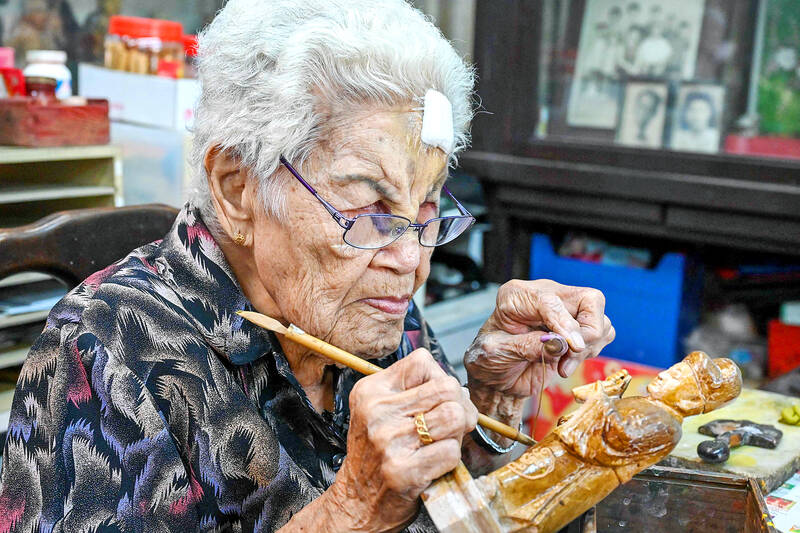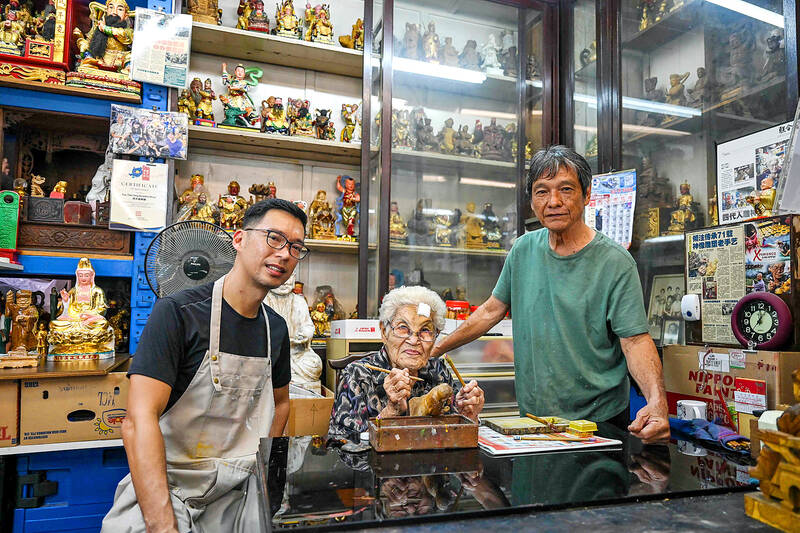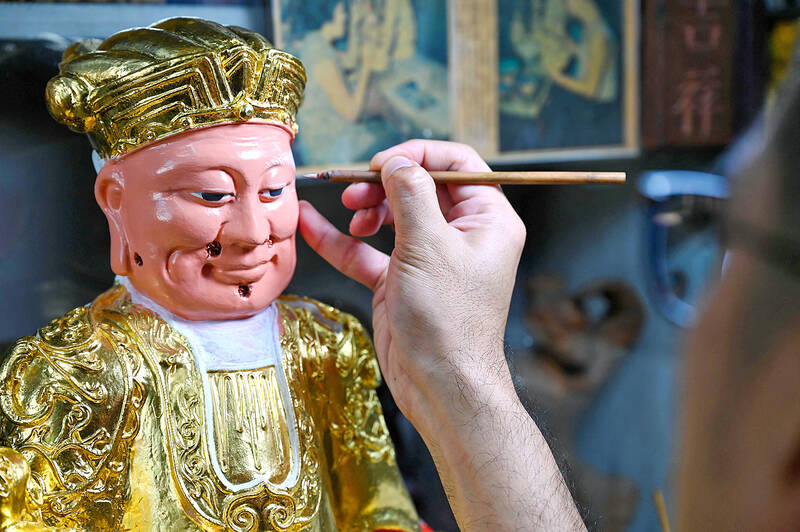Tan Chwee Lian picks up a small paddle, her finger resting on a groove worn into the wood over 70 years of making Buddhist and Taoist deities in her shop, one of the last of its kind in Singapore.
Facing competition from mass-produced items and lacking heirs to take up the trade, the traditional craft is in danger of dying out.
Tan’s more-than-a-century-old shop in downtown Singapore, tucked between hip cafes and boutiques, is one of the city-state’s last effigy establishments still making the wooden statues by hand.

Photo: AFP
The 92-year-old great-grandmother has been making the wooden statues since her arranged marriage to effigy craftsman Ng Tian Sang at the age of 18.
“I sat beside (my husband) and watched... when he left to buy things or run errands I would take over, then he would come back and tell me what I did wrong,” Tan said while using the wooden paddle to roll out a piece of dough made of joss stick ash using a secret family recipe.
She rolled out the mixture until it was a thin thread, then used two bamboo sticks to attach it to a wooden statue in an intricate pattern to demonstrate thread sculpture, a traditional carving technique from southeastern China. Although she is now retired from crafting, she comes to the Say Tian Hng Buddha Shop daily, helping out with odd tasks from her desk at the front of the traditional shophouse stacked with hundreds of gods looking out from the shelves.

Photo: AFP
Her son, 71-year-old Ng Yeow Hua, runs the shop, making, selling and repairing Taoist and Buddhist idols for temples and devotees.
Like many Singaporeans, the family’s origins can be traced back to China, from where many people emigrated in the 19th and early 20th centuries in search of a better life.
Ng’s grandfather founded the shop along with his brother in 1896, after moving to Singapore from Kinmen, an island in modern-day Taiwan.

Photo: AFP
Ng’s son, Ng Tze Yong, is now reinventing the business by running tours of the workshop as well as educational programs on Chinese culture.
Ng hopes the art can be passed down through the generations.
“If (my son) has the interest he can continue, but don’t force it,” he said.
To ensure that the art continues, the 43-year-old former journalist decided to become an apprentice several years ago. He now works in the shop one day a week, in addition to his day job at a local charity.
‘BEAUTY OF IMPERFECTION’
Handmade effigies take up to three months to make by artisans who must pick up the skills over years of informal learning and are entrusted with trade secrets passed down over generations. In comparison, machine-made statues are mass-produced, cost a fraction of the price and can be delivered quickly. “The customers that come to us believe in the beauty of imperfection, of things made by hand... in the authenticity of something that is made to worship divinity,” the younger Ng said.
“But yes, it has caused a decline in the business,” he admitted. “I’m trying to learn the craft from my dad and my grandma before it’s too late.”
In addition to learning decorative techniques, he must familiarize himself with scores of Taoist deities, each with a unique story.
“In Taoism (there) is this idea that you don’t have to be perfect. None of these gods are perfect,” he said.
For example, legend has it that the monkey god rebelled against heaven but redeemed himself after protecting a monk on a journey to procure holy texts from India. He is sometimes depicted with golden eyes believed to be able to spot evil. For the family, the pieces play an important role in the lives of their customers when they are going through rough patches.
“Throughout that time, these effigies were the ones that gave them the hope and encouragement to move on... so we take that very seriously,” Ng said.
He is recording all of his family’s knowledge and eventually hopes to take on other apprentices to ensure the shop can keep operating beyond his generation.
“The fact is that if (I) don’t do anything, the shop dies.”

On April 26, The Lancet published a letter from two doctors at Taichung-based China Medical University Hospital (CMUH) warning that “Taiwan’s Health Care System is on the Brink of Collapse.” The authors said that “Years of policy inaction and mismanagement of resources have led to the National Health Insurance system operating under unsustainable conditions.” The pushback was immediate. Errors in the paper were quickly identified and publicized, to discredit the authors (the hospital apologized). CNA reported that CMUH said the letter described Taiwan in 2021 as having 62 nurses per 10,000 people, when the correct number was 78 nurses per 10,000

As we live longer, our risk of cognitive impairment is increasing. How can we delay the onset of symptoms? Do we have to give up every indulgence or can small changes make a difference? We asked neurologists for tips on how to keep our brains healthy for life. TAKE CARE OF YOUR HEALTH “All of the sensible things that apply to bodily health apply to brain health,” says Suzanne O’Sullivan, a consultant in neurology at the National Hospital for Neurology and Neurosurgery in London, and the author of The Age of Diagnosis. “When you’re 20, you can get away with absolute

May 5 to May 11 What started out as friction between Taiwanese students at Taichung First High School and a Japanese head cook escalated dramatically over the first two weeks of May 1927. It began on April 30 when the cook’s wife knew that lotus starch used in that night’s dinner had rat feces in it, but failed to inform staff until the meal was already prepared. The students believed that her silence was intentional, and filed a complaint. The school’s Japanese administrators sided with the cook’s family, dismissing the students as troublemakers and clamping down on their freedoms — with

As Donald Trump’s executive order in March led to the shuttering of Voice of America (VOA) — the global broadcaster whose roots date back to the fight against Nazi propaganda — he quickly attracted support from figures not used to aligning themselves with any US administration. Trump had ordered the US Agency for Global Media, the federal agency that funds VOA and other groups promoting independent journalism overseas, to be “eliminated to the maximum extent consistent with applicable law.” The decision suddenly halted programming in 49 languages to more than 425 million people. In Moscow, Margarita Simonyan, the hardline editor-in-chief of the